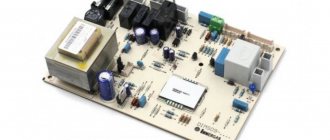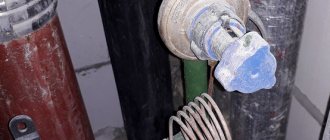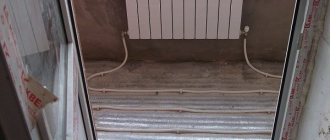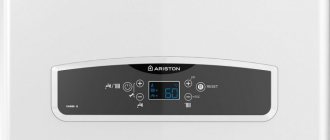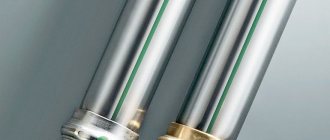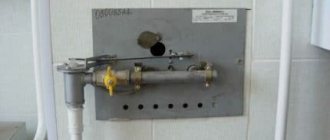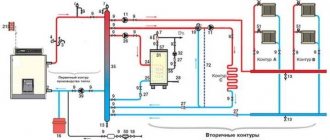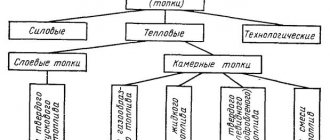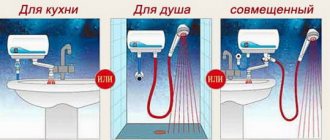Kinds
Automation for solid fuel units can be classified according to autonomy.
There are two types here:
- Automation that does not require electricity.
- Automation powered by electricity. This type performs all its functions only if it is connected to a power source. Of course, it is also equipped with a backup reserve if the power supply is suddenly interrupted. So, even if the electricity supply is interrupted, the boiler will continue to work for some time.
Of these two options, it is the second option that is recommended, since it has a large number of diverse functions and effectively fulfills its obligations.
Types and advantages of automatic devices for gas boilers
The automatic control unit for a gas boiler can operate autonomously or from the network
Automation for a gas boiler is traditionally classified according to the degree of its dependence on the energy supply. According to this feature, they distinguish:
- volatile systems that operate only when electricity is available;
- non-volatile electronics that do not require connection to the electrical network.
The second option usually uses a backup UPS. Many users prefer power-dependent systems because they have greater functionality. The second option for powering automatic heating systems is relevant for situations where there are constant power outages in a particular area, and the device itself operates reliably from simple electronics.
The advantages of automatic gas boilers as controlled units include:
- the ability to maintain the temperature in heating circuits at a fixed level without human intervention;
- ability to work in automatic mode for a long time (up to 48 hours);
- the presence of an automatic ignition system for solid and gas fuels;
- limiting operator intervention in controlling a floor-standing or wall-mounted boiler.
The user just needs to set a certain temperature regime, which is constantly maintained within the living space.
An important advantage of gas heating boilers equipped with automatic equipment is independence in critical operating conditions. In case of urgent shutdown, there is no need to wait for it to cool completely.
There is no need to drain the coolant for fear of defrosting the system. Automation will perform all these operations at the command of the owner who is not within the house. Using telephone-controlled electronics, you can set the required operating mode of the gas boiler and, if desired, optimize it.
Advantages and disadvantages
Automation for solid fuel furnaces has a large number of advantages, and only one drawback. They will be discussed below.
So, the advantages:
- Automatic temperature adjustment. Previously, a person had to set the damper at the right level to increase and decrease the temperature in the boiler. Now, modern solid fuel stoves will take care of this themselves. A person only needs to adjust the temperature and that’s it! During operation, the boiler will check the temperature and, using special devices such as a fan or pump, will limit or increase the air supply. If the temperature inside the boiler rises, the air supply is automatically limited, and if the temperature is below the set norm, the air supply is increased.
- Independent operation of the boiler. Previously, if the owner needed to go somewhere for several days, he had to completely turn off the boiler, that is, take it out of the operating phase. With modern units everything is different. Thanks to automation, you can set the minimum parameters for the stove before leaving, and when you arrive, the house will be warm and cozy.
- Ignition of fuel. Now there is no need to ignite the fuel. The system will do this automatically.
- Safety. Modern units have the highest level of safety. The system is equipped with special devices that are capable of detecting the breakdown or failure of one or another element. This will be indicated by a sharp jump in temperature, change in pressure, etc. If this is detected, the system automatically stops operation and makes a sound, so the owner can quickly find out about the malfunction and call a specialist.
- Electricity reserve. If the power supply is suddenly interrupted, the unit will continue to operate for some time.
- Self-loading of fuel. Modern boilers have a special tank in which firewood or other types of fuel are stored. Automation is capable of automatically loading fuel into the combustion chamber. Now the ash pan is also cleaned automatically without human intervention.
- Control system. There are types of automation where a person, by clicking on special screen elements, must set certain values. But there are also options where a person does not need to approach the system and can simply control the remote control, and the signal is picked up at a fairly large distance.
These are the advantages of automation. It must be said that all this is aimed at making human life as comfortable as possible and the boiler as safe as possible. Automation has only one drawback - energy dependence.
Features of installing automation on the boiler
The installation of automation on a solid fuel boiler should be carried out by a professional technician. The procedure has quite a few nuances that must be taken into account. Incorrect installation will make it impossible for the unit to function normally and all efforts to replace the control unit will be in vain. The cost of the service is very low, so you won’t be able to save a lot of money on this. But the damage from incorrect actions and subsequent breakdown will be noticeable.
After completing installation work, correct calibration must be carried out. You can do this yourself using the included instructions, or seek help from the specialist who carried out the installation. The automation for the boiler is configured according to the following scheme:
- 1. First, you need to fill the heating system with coolant and bleed all the air out of it so that there are no plugs that will interfere with normal circulation. It won't be difficult at all to do this.
- 2. Then you need to start the circulation pump and check that it begins to drive water through the system without any obstacles.
- 3. When the water in the system begins to circulate, you need to check the readings on all emergency thermostats, as well as the water level and its pressure in the system. All indicators must be within acceptable limits.
- 4. Now you can proceed directly to ignition. Each automation has its own characteristics of starting the flame into the combustion chamber, so at this stage you must strictly adhere to the requirements of the operating instructions.
- 5. When ignition is completed, you need to add the specified amount of fuel into the firebox and set the desired operating parameters. Occasionally you will need to add fuel and check the readings of control devices with the norm.
Design and operating principle
The automation that controls the operation of a gas boiler consists of many elements, conditionally divided into two subgroups. The first includes mechanisms that ensure the full and safe functioning of the boiler itself. The second includes devices that make it possible to operate the heating system in the most convenient and user-friendly mode.
Components of a security system
Several modules are responsible for the operational safety of the unit:
- Flame controller - consists of two main parts - a solenoid valve and a thermocouple. Shuts off gas promptly and reliably and prevents leakage.
- Thermostat - maintains the set temperature of the coolant and protects the system from overheating. When the coolant cools down to minimum temperatures, the module starts the boiler into operation, and after recording peak-high readings, it turns it off, completely relieving the owners of the need to constantly pay attention to the system.
- The draft control sensor is responsible for stopping the gas supply to the burner in the event of a change in the basic position of the bimetallic plate, thus preventing gas leakage.
- Safety valve - monitors the amount of coolant in the circuit.
In addition to all the above useful qualities, the automation has a number of additional functions that increase the comfort of using the equipment.
The device performs automatic ignition of the gas burner, selects the most effective operating mode, promotes rational consumption of energy resources and conducts independent diagnostics, saving the owners from all these activities.
Operating principle of security automation
Current regulatory documentation says that the safety system for gas boilers must be equipped with a device that stops the operation of the entire system and shuts off the gas supply in the event of an unexpected breakdown or any other force majeure circumstances.
Conclusions and useful video on the topic
On the presented video you will find brief instructions for installing a gas boiler equipped with an automatic Eurosit system.
A modern gas boiler is a rather complex design that provides many useful functions. The automation of most models greatly facilitates their operation, taking over control of the mechanisms and monitoring their operation. This significantly increases the level of safety during the operation of the heating system, and also increases its efficiency by selecting the optimal mode.
Strapping scheme
A solid fuel unit is usually connected to a boiler that runs on a different type of fuel. This is usually an electrical unit.
An electric one is installed parallel to the solid fuel stove. This is the so-called auxiliary element. Its role is as follows: if, for example, the owners are not in the house for a long time, and the solid fuel boiler has run out of fuel, then the auxiliary element, in this case, the electric unit, automatically comes into working condition. It maintains positive temperatures. More on how it all works.
First, the coolant under pressure from the circulation pump is supplied to the boiler, passing through which it heats up. Next, the coolant enters the radiator, where movement follows the principle of natural circulation. Then it enters a special boiler, inside of which there is a coil that is immersed in water. The coolant, passing through the coil, heats it, as a result of which the water heats up. Thus, the residents of the house are provided with hot water.
After the boiler, the coolant again enters the radiators and underfloor heating coils. But before that, he must pass a special crane. If the temperature of the coolant corresponds to the established norm, then the tap opens and the coolant circulates through the floor coils, and if the temperature is higher than normal, the tap closes.
How to setup
As a rule, all devices have instructions from the manufacturer, which detail step-by-step instructions on how to set up a newly installed device.
In general, all steps boil down to the following points:
- First, the heating system must be filled with coolant. At the same stage, the presence of air cavities inside the system is checked. They shouldn't exist.
- Now the circulation pump is activated. Here you need to make sure that it adjusts the coolant without any obstacles.
- After the circulation pump is started, it is necessary to check the thermostat indicators, where temperature and pressure indicators will be given. All these indicators must be within the limits established in the instructions.
- If all indicators are normal, then you can start ignition. Here you should fulfill all the requirements specified in the instructions without exception, since automation devices from different manufacturers release flames into the combustion chamber in completely different ways and have a number of their own characteristics.
- When everything is completed, you should throw a certain amount of fuel into the firebox (this amount is usually indicated in the instructions) and set the necessary parameters. It is recommended to add fuel several times and check the instrument readings to ensure they do not go beyond normal limits.
Installation. Step-by-step instruction
The installation of automation should be carried out by a professional who knows his business. This process is very complex and hides a large number of nuances that must be taken into account. There is no need to skimp on the services of an installation specialist; it is already inexpensive.
If you take on this work yourself, then there is a big risk of making mistakes, for which you will have to pay for them in material resources many times over, since you will have to replace most of the boiler elements.
- The first thing specialists usually do is install a ventilation system. It is usually installed at the bottom of the boiler, where the damper is located. First, the damper is removed, then the fan is installed. It must be secured with four fasteners.
- The next step is to install the controller. The controller is a control unit. Specialists install it in the upper part of the boiler. But it can also be installed on the side.
- Then the automation is configured. Setting up the automation will be discussed in more detail below.
- The system is then connected to a power source and tested. There may also be many other options depending on the manufacturer.
Automatic blocks of floor-standing boilers
The vast majority of floor-standing gas boilers are equipped with automatic safety systems that operate without an external power source (non-volatile). According to the requirements of regulatory documents, automation equipment must shut off the gas supply to the burner and igniter in three emergency cases:
- Extinction of the main burner flame due to blowing out or for other reasons.
- When natural draft in the chimney channel is absent or sharply reduced.
- The drop in natural gas pressure in the main pipeline is below a critical level.
For reference. The implementation of the listed functions is mandatory for gas boilers of all types. Many manufacturers add a fourth level of safety – overheating protection. When the coolant temperature reaches 90 °C, the valve, based on a signal from the sensor, stops supplying gas to the main burner.
Various models of gas floor-standing boilers from different manufacturers use the following types (brands) of non-volatile automation:
- Italian blocks EuroSIT (Eurosit) series 630, 710 and 820 NOVA (heating units Lemax, Zhitomir 3, Aton and many others);
- Polish devices "KARE" (heat generators "Danko", "Rivneterm");
- American automatic control devices Honeywell (Zhukovsky heaters);
- domestic products, "Arbat".
Automation for gas boilers
This definition means a system of actuating and control devices aimed at maintaining specified modes, as well as promptly responding to emergency situations.
This ensures the safe use of boilers with minimal human involvement in the processes occurring in the device.
The design of gas boilers includes various types of automatic devices (electronic and mechanical) that are designed to maintain efficient, safe operation
All automation used for the correct functioning of heating devices can be divided into two fundamental groups:
- autonomous, not dependent on external power supply;
- devices that require an external source of electrical current to operate.
Let's look at each group of devices in detail.
Connecting automation to a solid fuel boiler
The installation process begins with a fan, which is installed on the air supply door or ash pan. Many modern solid fuel models already have places and holes for mounting the supercharger. Otherwise, you need to drill the holes yourself and secure the boost fan with four bolts.
Please note the presence of a heat-resistant gasket: it is required, but not available on all fan models. As a result, the turbine should be installed in accordance with the photo below.
Properly installed boost fan.
The second step is the installation and connection of the automation itself to the solid fuel boiler. The controller is installed on top or on the side of the case through the device holes intended for this purpose. Despite the fact that the body of many controllers is made of heat-resistant materials, it is advisable to install the device on the coldest part of the boiler body, if necessary, placing a heat-resistant gasket made of non-flammable material.
All that remains is to connect all the elements and connect the controller to the power supply. A detailed connection diagram is always indicated in the automation instructions, for example, this is what the connection diagram to the Komfort ECO control unit looks like:
Automation connection diagram using Komfort ECO as an example.
How to set up
The detailed setup algorithm also depends on the model and is always described in the instructions. In general terms, the setup implies the following procedure:
- Setting the temperature for turning on the circulation pump - allows you to turn on the pump not immediately, but when the coolant has already warmed up, it is necessary to prevent the formation of condensation (usually set to 50°C).
- Setting the desired temperature of the heating circuit or room air, depending on the model and controls.
- Setting the fan rotation speed (from 1 to 10) or selecting one of the automatic fan speed control modes. When setting the boost completely manually, you also need to set the parameters for the fan operating time and the frequency of its activation in combustion support mode.
- Adding fuel and igniting the boiler. Monitoring its operation and, if necessary, adjusting parameters.
In some models, you can also program operation for a day or a week in advance, set a temperature threshold, after which the fan will begin to gradually reduce speed, etc.
Instructions Boilers Solid fuel boilers
How to setup
As a rule, all devices have instructions from the manufacturer, which detail step-by-step instructions on how to set up a newly installed device.
In general, all steps boil down to the following points:
- First, the heating system must be filled with coolant. At the same stage, the presence of air cavities inside the system is checked. They shouldn't exist.
- Now the circulation pump is activated. Here you need to make sure that it adjusts the coolant without any obstacles.
- After the circulation pump is started, it is necessary to check the thermostat indicators, where temperature and pressure indicators will be given. All these indicators must be within the limits established in the instructions.
- If all indicators are normal, then you can start ignition. Here you should fulfill all the requirements specified in the instructions without exception, since automation devices from different manufacturers release flames into the combustion chamber in completely different ways and have a number of their own characteristics.
- When everything is completed, you should throw a certain amount of fuel into the firebox (this amount is usually indicated in the instructions) and set the necessary parameters. It is recommended to add fuel several times and check the instrument readings to ensure they do not go beyond normal limits.
